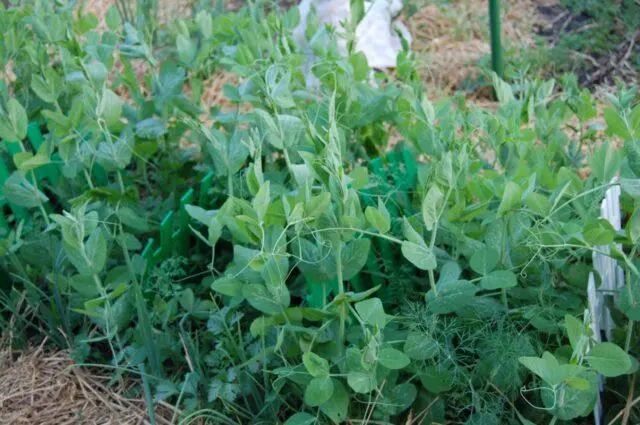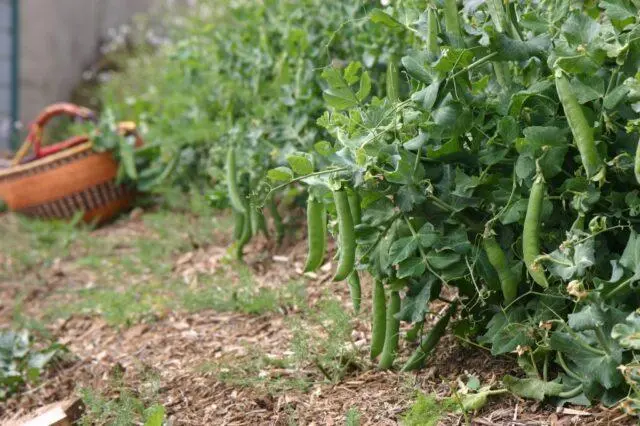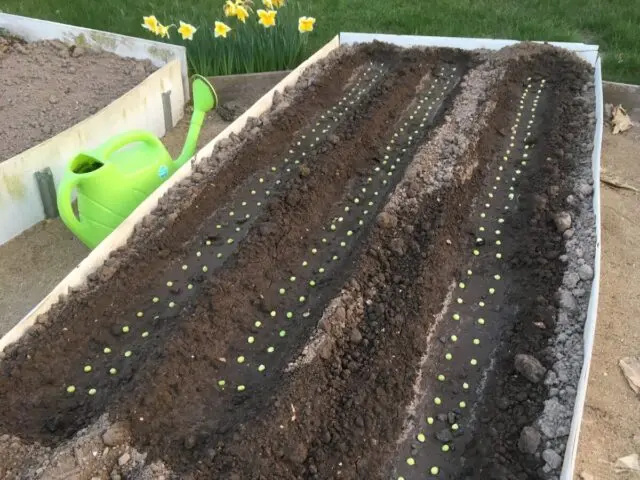Contents
Competently and in a timely manner to feed peas in the open field means to ensure good growth and development for it, and for yourself a high yield with excellent taste characteristics. Various types of fertilizers are used for crops. It is important to observe the terms and dosage, safety rules.
Rules for feeding peas in the open field
Proper fertilization is essential for any crop. When feeding peas, you need to follow these rules:
- When sowing, use water-soluble formulations.
- After planting in open ground, top dressing should not be carried out for at least two weeks. This period is spent on the adaptation of culture in a new place.
- When using fertilizer solutions, it is important to pre-water the peas abundantly. This measure prevents burns of the root system.
- Foliar top dressing is best planned for the evening, when the activity of the sun ends. If the day is overcast, work can be done early in the morning.
- Do not exceed recommended dosages. Highly concentrated fertilizers can cause burns of the root system, the aerial parts of plants.
- Use nitrogen sparingly. With its excess, nitrates accumulate in the fruits, and the shelf life is reduced.
- Organic fertilizers should not be placed under plants, otherwise the risk of gaining excess biomass and root rot increases.

Pea itself is a fertilizer for other plants, enriching the soil with nitrogen compounds.
Fertilizers for peas in the garden before planting
The need for top dressing of peas before planting depends on the preparation of the site in the fall. If the soil is fertile and slightly acidic, then when digging, a potassium-phosphorus complex is added, per 1 m²:
- potassium salt 30 g;
- superphosphate 60 g.
In the spring, they dig up the earth again, add 10 g of saltpeter per 1 m². In addition to fertilizing the soil, seeds are treated before planting. Effective use of micro and macro elements:
- molybdenum;
- iodine;
- iron;
- manganese;
- copper;
- cobalt.
Types of fertilizers for peas
Peas are an unpretentious culture, therefore, when grown on fertile soil, some gardeners do without top dressing. In fact, the plant is demanding on the composition of the soil. With a shortage of certain elements, its condition, qualitative and quantitative characteristics of the crop may suffer.
Organic Fertilizers
Many experts do not recommend using organic matter for peas. Bring it under the previous culture.
Popular options are:
- green manure;
- manure;
- bird droppings;
- peat;
- compost.
Potassium-phosphorus fertilizers for peas
Peas intensively absorb phosphorus. The element has several important tasks:
- stimulation of the growth of the root system;
- increased activity of nodule bacteria;
- reduction of harmful effects with excess nitrogen.
Potassium is important for phosphorus metabolism in the crop nutrition system. A sufficient amount of the element provides the following benefits:
- increased drought resistance;
- strengthening immunity to diseases;
- improved metabolism.
With a lack of potassium, the tissues of old leaves begin to die.

Excess potassium is fraught with accelerated formation and maturation, short stature of plants, grinding beans
Trace Elements
Trace elements affect the speed of various processes in the life of plants. Their shortage will not destroy the culture, but it can reduce the qualitative and quantitative characteristics of the crop.
One of the most important elements for peas is molybdenum. Its meaning is great:
- regulation of nitrogen, phosphorus and hydrocarbon exchanges;
- neutralization of nitrates;
- influence on the rate of redox processes;
- influence on the formation of chlorophyll, the production of vitamins.
The lack of molybdenum negatively affects metabolic processes, slows down the synthesis of proteins and amino acids. As a result, the yield and its quality are reduced. Fertilizer is applied in the form of ammonium molybdate or ammonium-sodium or molybdenized superphosphate.
Another important trace element for peas is manganese. It has several tasks:
- activation of enzymes;
- promoting the synthesis of vitamins, carbohydrates, proteins;
- participation in respiration, photosynthesis, protein-carbohydrate metabolism.
With a deficiency of manganese, the color of pea leaves becomes lighter, dead areas appear. The culture is more susceptible to chlorosis, the root system does not fully develop.
For peas, boron is important, which, together with manganese, catalyzes photosynthesis reactions. The element is necessary for culture throughout the entire life cycle.
Copper is one of the most important trace elements for peas. More often it is used in the form of copper sulfate. The role of the substance is:
- participation in photosynthesis;
- regulation of protein transport;
- doubling the content of phosphorus and nitrogen;
- protection of chlorophyll from destruction.

Copper is not only a fertilizer, but also a means for the treatment and prevention of many diseases.
Bacterial
The use of microorganisms in the cultivation of peas contributes to its nutrition. Popular options are:
- Agrophile;
- Rhizoagrin;
- Mizorin;
- Rhizotorphin;
- Flavobacterin.
Bacteria for such fertilizers are usually isolated from the roots of healthy plants. The drugs act in a complex manner, stimulating growth and development, improving nutrition and moisture exchange, increasing immunity.
Bacterial preparations can poison seeds, feed peas in June or other months. The dosage depends on the season and purpose of use.
Feeding times
Opinions on the timing of top dressing vary. The famous candidate of agricultural sciences Oktyabrina Ganechkina advises to use fertilizers twice:
- during flowering;
- when the first blades appear.
Nitrogen fertilizers for feeding peas in the spring are applied before sowing. Urea (grade B urea) is usually used.
The introduction of phosphorus and potash fertilizers for peas is carried out in the fall for digging. If this stage is skipped, then it can be carried out in the spring, but the efficiency will decrease by 30-50%.
Fertilizer application methods and dosage
Top dressing of peas during flowering and fruiting is carried out by root or foliar method. In addition to these methods, there are pre- and pre-sowing fertilization. Features of their application depend on the chosen form of substances.
Fertilizer name | Method of application | Dosage per 1 m² |
liquid organics | Root, use a watering can without a strainer | 3 liters of solution, prepare from 1 tbsp. l. on a bucket |
Nitroammophoska | When watering, it must be dissolved in water | 1 Art. l. for 10 liters |
Ammonia molybdate | In the soil before sowing or in the rows during it | 0,02-0,03 g |
manganese sludge | 3 g | |
bora | 0,03-0,06 g | |
Copper sulfate | 1-2,5 g | |
Boric acid | Spraying seeds | For 100 g of seeds 10 mg in 1 liter of water |
Urea | Under spring digging | 2-12 g |
Nitrogen fertilizers in granules | Apply until abundant watering, when the plants reach 5-8 cm. | 20 g |
When sowing, the compositions are applied in a dry form. It is more convenient to make grooves for planting, not holes. After placing the fertilizer, sprinkle with earth. Minimum layer 2 cm.

When planting fertilizers, you can apply not in the same furrow where the seeds are sown, but in an additional one – they do it at a distance of 2 cm
It is allowed to feed peas in the open field with folk remedies:
- When shoots appear – a green infusion of nettles and dandelions.
- To stimulate growth, yeast 1:20, infusions of wormwood, chamomile, yarrow, shepherd’s purse. Dry the plants, grind, add a handful to 1 liter of warm water, leave for a week. Use as a spray.
- Feeding peas with ash. This fertilizer is saturated with magnesium salts, a glass per 1 m² is enough. Ash is also useful in acidic soil. They bring it in the fall, 0,3 kg per 1 m².
- Mullein. Dilute in ten parts of water. Use at the beginning of flowering, reapply in the mass formation of beans.
It is better to feed peas during flowering with liquid fertilizers.
Safety regulations
When feeding peas, it is important to remember not only the rules for applying the compositions, but also safety.
Highlights:
- Use personal protection. Closed clothing and gloves are required. If fertilizers are applied in the form of sprays, protect yourself with a respirator or mask.
- After finishing work with fertilizers, wash your hands and face thoroughly. Use soap.
- Do not exceed the recommended dosage. This can be harmful not only for culture, but also for humans and the environment.
- When fertilizing, exclude weeding and loosening the soil.
- Do not store fertilizers near food, drinking water, clean clothes, hygiene items.
An important point is the proper storage of fertilizers. If its conditions are violated, the effectiveness of the composition may be lost, its properties may change. When buying, be sure to read the instructions and other recommendations on the package.
Conclusion
With proper preparation of the site in the fall, it is enough to feed the peas in the open field twice during the season, since the culture is undemanding to growing conditions. She needs some trace elements, potassium-phosphorus fertilizers. It is important not to abuse top dressing, to follow the rules for their application and safety of use.









